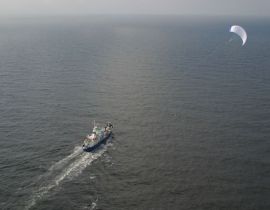 ‘Sensorchute’ winner of Defence Innovation Game
‘Sensorchute’ winner of Defence Innovation Game
‘Improved Perception in Large Operation Areas’ has recently been chosen as the best technology project of the Innovation Game 2012. The project is a collaborative effort involving NLR, Thales Netherlands and Defence Material Organisation (DMO).
Of the seven participating teams, the team that devised an innovative technique for combating piracy and smuggling was chosen as the winner. This technique can also be used for border control.
The available surveillance capacity of the navy in an operational area is often too limited to be effective. To enlarge the awareness in such an area, the winning team came up with a technique which would render the radar range three times larger, thus allowing the navy to monitor larger areas.
The technique involves a radar system that must be adapted to have a larger scope and required accuracy. The radar must first also be stabilised. The system can be hung above a frigate by use of a parachute. The radar will then have a larger range and increase the situational awareness, because it hangs higher (elevated sensor platform). The mechanism of the parachute trailing behind the ship can be compared to a kite that elevates as one runs.
Thales focused on the radar aspect of the project, focusing on the optimal sensor height for the detection of ‘small targets’, meaning the small boats in which pirates and smugglers travel. These boats are often virtually undetectable with radar. NLR calculated that the parachute system will have a span of 10 meters and will be able to carry a load weighing 325 kg. For this, NLR utilised its knowledge pertaining to previous parachute systems, such as Spades.
The Defence Innovation Game is an annual event in which representatives of institutes, companies and the Ministry of Defence work on innovative ideas. The game is presented in the form of a competition and is organised by Defence R&D.

